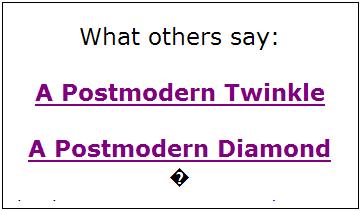The Hole
Part I: Mathematics and Narrative

Apostolos Doxiadis on last month's conference on "mathematics and narrative"–
Doxiadis is describing how talks by two noted mathematicians were related to
"… a sense of a 'general theory bubbling up' at the meeting… a general theory of the deeper relationship of mathematics to narrative…. "
Doxiadis says both talks had "a big hole in the middle."
"Both began by saying something like: 'I believe there is an important connection between story and mathematical thinking. So, my talk has two parts. [In one part] I’ll tell you a few things about proofs. [And in the other part] I’ll tell you about stories.' …. And in both talks it was in fact implied by a variation of the post hoc propter hoc, the principle of consecutiveness implying causality, that the two parts of the lectures were intimately related, the one somehow led directly to the other."
"And the hole?"
"This was exactly at the point of the link… [connecting math and narrative]… There is this very well-known Sidney Harris cartoon… where two huge arrays of formulas on a blackboard are connected by the sentence ‘THEN A MIRACLE OCCURS.’ And one of the two mathematicians standing before it points at this and tells the other: ‘I think you should be more explicit here at step two.’ Both… talks were one half fascinating expositions of lay narratology– in fact, I was exhilarated to hear the two most purely narratological talks at the meeting coming from number theorists!– and one half a discussion of a purely mathematical kind, the two parts separated by a conjunction roughly synonymous to ‘this is very similar to this.’ But the similarity was not clearly explained: the hole, you see, the ‘miracle.’ Of course, both [speakers]… are brilliant men, and honest too, and so they were very clear about the location of the hole, they did not try to fool us by saying that there was no hole where there was one."
Part II: Possible Worlds
"At times, bullshit can only be countered with superior bullshit."
— Norman Mailer
Many Worlds and Possible Worlds in Literature and Art, in Wikipedia:
"The concept of possible worlds dates back to a least Leibniz who in his Théodicée tries to justify the apparent imperfections of the world by claiming that it is optimal among all possible worlds. Voltaire satirized this view in his picaresque novel Candide….
Borges' seminal short story El jardín de senderos que se bifurcan ("The Garden of Forking Paths") is an early example of many worlds in fiction."
Background:
Modal Logic in Wikipedia
Possible Worlds in Wikipedia
Possible-Worlds Theory, by Marie-Laure Ryan
(entry for The Routledge Encyclopedia of Narrative Theory)
The God-Shaped Hole
Part III: Modal Theology
"'What is this Stone?' Chloe asked….
'…It is told that, when the Merciful One made the worlds, first of all He created that Stone and gave it to the Divine One whom the Jews call Shekinah, and as she gazed upon it the universes arose and had being.'"
— Many Dimensions, by Charles Williams, 1931 (Eerdmans paperback, April 1979, pp. 43-44)
"The lapis was thought of as a unity and therefore often stands for the prima materia in general."
— Aion, by C. G. Jung, 1951 (Princeton paperback, 1979, p. 236)
"Its discoverer was of the opinion that he had produced the equivalent of the primordial protomatter which exploded into the Universe."
"We symbolize
logical necessity
with the box ( ) )
and logical possibility
with the diamond ( ). )."
— Keith Allen Korcz

"The possibilia that exist,
and out of which
the Universe arose,
are located in
a necessary being…."
— Michael Sudduth,
Notes on
God, Chance, and Necessity
by Keith Ward,
Regius Professor of Divinity
at Christ Church College, Oxford
(the home of Lewis Carroll)
|













